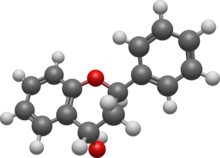Flavan-4-ol
Appearance
(Redirected from 3-deoxyflavonoids)

| |

| |
| Names | |
|---|---|
| IUPAC name
Flavan-4-ol
| |
| Systematic IUPAC name
2-Phenyl-3,4-dihydro-2H-1-benzopyran-4-ol | |
| Other names
2-Phenylchroman-4-ol
| |
| Identifiers | |
3D model (JSmol)
|
|
PubChem CID
|
|
| |
| Properties | |
| C15H14O2 | |
| Molar mass | 226.275 g·mol−1 |
Except where otherwise noted, data are given for materials in their standard state (at 25 °C [77 °F], 100 kPa).
| |
The flavan-4-ols (3-deoxyflavonoids) are flavone-derived alcohols and a family of flavonoids. Flavan-4-ols are colorless precursor compounds that polymerize to form red phlobaphene pigments.[1] They can be found in the sorghum.[2] Glycosides (abacopterins A, B, C and D together with triphyllin A and 6,8-dimethyl-7-hydroxy-4‘-methoxyanthocyanidin-5-O-β-d-glucopyranoside) can be isolated from a methanol extract of the rhizomes of Abacopteris penangiana.[3]
Known flavan-4-ols
[edit]Metabolism
[edit]Flavanone 4-reductase is an enzyme that uses (2S)-flavan-4-ol and NADP+ to produce (2S)-flavanone, NADPH, and H+.
Spectral data
[edit]These compounds have absorption maxima of 564 nm.[4]
References
[edit]- ^ Styles, E. D., & Ceska, O. (1977). The genetic control of flavonoid synthesis in maize. Canadian Journal of Genetics and Cytology, 19(2), 289–302. doi:10.1139/g77-032
- ^ Jambunathan, Ramamurthi; Kherdekar, Milind S. (1991). "Flavan-4-ol concentration in leaf tissues of grain mold susceptible and resistant sorghum plants at different stages of leaf development" (PDF). Journal of Agricultural and Food Chemistry. 39 (6): 1163–1165. doi:10.1021/jf00006a035.
- ^ Zhao, Zhongxiang (2006). "Flavan-4-ol Glycosides from the Rhizomes of Abacopteris p enangiana". Journal of Natural Products. 69 (2): 265–268. doi:10.1021/np050191p.
- ^ Sekhon, Rajandeep S.; Chopra, Surinder (2009). "Progressive Loss of DNA Methylation Releases Epigenetic Gene Silencing from a Tandemly Repeated Maize Myb Gene". Genetics. 181: 81–91. doi:10.1534/genetics.108.097170. PMC 2621191.